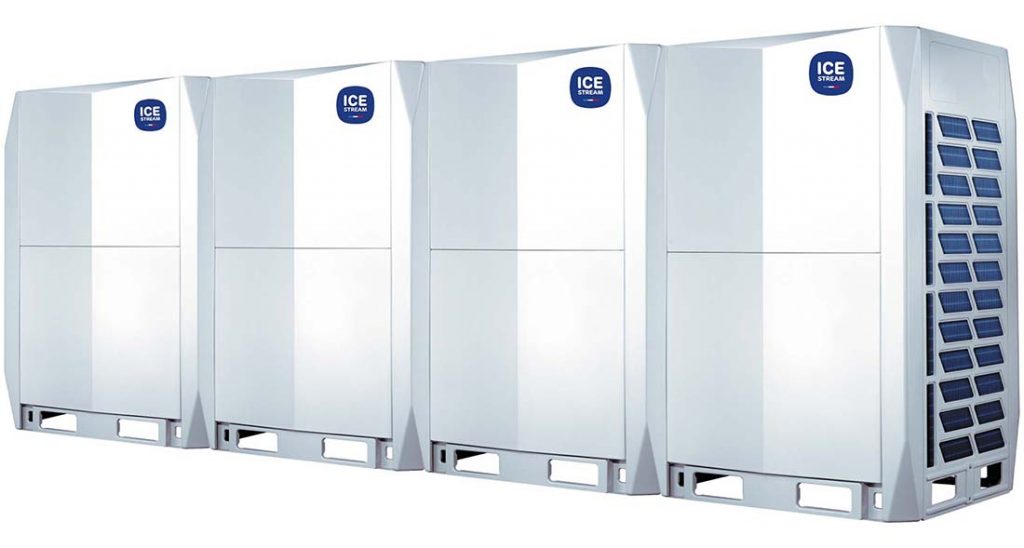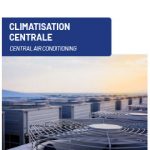Climatisation centrale
😀 Product Benefits
- 8 to 270 kW
- Up to 1000 meters of pipes
- Compatible with numerous indoor units
📁 Technical Manuals
Air conditioning VRV (Variable Refrigerant Volume) is an innovative and highly efficient solution for cooling and heating indoor spaces. This advanced air conditioning system offers numerous advantages in terms of both comfort and energy efficiency.
What is the VRV system?
The VRV (Variable Refrigerant Volume) system, also known as DRV (Variable Refrigerant Flow), is a direct expansion air conditioning technology designed for large private, semi-private, and commercial buildings such as offices and hotels.
This innovative system consists of one or more outdoor units and a potentially large number of indoor units, up to 50 and beyond. It offers reversible air conditioning capabilities, providing both cooling and heating, as well as energy recovery features.
This type of central air conditioning is based on the concept of variable refrigerant flow. This system allows precise regulation of the amount of refrigerant sent to each indoor unit, based on the needs of each zone. Thus, it provides flexibility and precise temperature control in each space.
It should be noted that VRV air conditioning is primarily intended for professional applications. It is designed to meet the requirements of large spaces and provide an optimal indoor climate in these specific environments.
Icestream Products
Outdoor Units
Icestream offers two types of outdoor units for VRV air conditioning systems:
MINI VRF
The MINI VRF range offers a power range from 8 kW to 45 kW. These units are designed to be very compact, facilitating integration into various environments. They are also equipped with intelligent defrosting technology and advanced noise reduction technology, ensuring quiet and efficient operation.
VRF 6
The VRF 6 range is ideal for large-scale installations, with a power range from 25.2 kW to 270 kW. These units allow great flexibility in the distribution of air conditioning due to the ability to install up to 1000 meters of pipes. Additionally, they are designed to accommodate significant height differences between the outdoor unit and indoor units, up to 110 meters.
Compatible Indoor Units
To complement the outdoor units, Icestream offers a wide range of compatible indoor units, providing a comprehensive solution. Here are some of the available indoor units:
- 1-way Cassette: 1.8 to 7.1 kW
- Compact 4-way Cassette: 2.2 to 4.5 kW
- Low Static Pressure Ducted: 1.8 to 7.1 kW
- Ducted with Fresh Air Processing Unit: 12.5 to 28 kW
- 2-way Cassette: 2.2 to 7.1 kW
- 4-way Cassette: 2.8 to 14 kW
- Medium Static Pressure Ducted: 2.2 to 14 kW
- High Static Pressure Ducted: 7.1 to 56 kW
- Ceiling and Floor: 3.6 to 16 kW
- Floor Standing Unit: 2.2 to 8 kW
- Console: 2.2 to 4.5 kW
- Wall-mounted Split: 2.2 to 9 kW
With this variety of indoor units, Icestream enables the creation of customized air conditioning systems tailored to the specific needs of each space. These products offer high performance, energy efficiency, and optimal comfort for users.
Operation
The DRV or VRV air conditioner is designed to ensure optimal comfort by providing ambient air at the appropriate temperature in professional premises. Its operation is based on a well-defined system.
Power Supply for Indoor Units
The VRV air conditioner consists of an outdoor unit, also called a compressor, which is responsible for supplying power to all indoor units. This is made possible through refrigerant lines, which are insulated copper tubes. These refrigerant lines transport the specific refrigerant fluid to the various indoor units.
Cooling Mode Operation
When used in cooling mode, it operates on the principle of direct expansion. The evaporator of the refrigeration machine directly cools the air in an air handling unit. Thus, no transport of water or air is necessary. It is the specific refrigerant fluid that plays a key role in this cooling process. This operation is repeated in each room where an indoor unit is installed.
Reversible Mode Operation
When the air conditioner is used in reversible mode, it can also provide heat. In this case, the heat exchanger serves a dual role as both evaporator and condenser. This mode change is made possible by using electronic expansion valves and a communication bus that allows coordination among all system equipment.
With these different functionalities, the air conditioner provides great flexibility and precise temperature management in each zone or room, ensuring optimal thermal comfort in professional spaces.
Applications
The air conditioning system is useful in various types of buildings, especially in large-scale spaces. Here are some examples of common uses:
Hotels
This air conditioning is ideal for hotels, as each room can be equipped with an individual indoor unit. This allows personalized comfort for each occupant.
Museums
Museums require specific ambient conditions to preserve artwork and valuable objects. Air conditioning provides precise regulation of temperature and humidity, ensuring optimal preservation.
Hospitals
In hospitals, air conditioning helps maintain comfortable conditions for patients, medical staff, and visitors. Additionally, it regulates air and maintains sterile environments in sensitive areas.
Schools and Universities
Schools, colleges, high schools, and university campuses benefit from air conditioning to ensure optimal comfort conditions in classrooms, libraries, and other common areas.
Offices and Commercial Spaces
Offices and commercial spaces in the tertiary sector can take advantage of this system to create pleasant and productive working environments, allowing each area to have a personalized temperature.
Large Residential Spaces
Large residences such as private houses, large villas, or estates can benefit from the advantages of this air conditioning system to maintain comfort conditions tailored to each space, offering optimal living comfort.
It is therefore a versatile and efficient choice to meet thermal comfort needs in various environments, offering tailored solutions for each specific use.
Advantages of VRV Air Conditioning
Energy Savings
This is one of the main claims of manufacturers of this type of equipment. It is estimated that energy savings achieved by these systems range on average between 11% and 20%.
Inverter Technology
Every compressor in this air conditioning system nowadays is of Inverter technology. The advantages of this technology are significant. If you want to learn more, check out our article: “→ What is inverter technology«.
Easy Installation
Unlike other equipment such as rooftop air conditioning, VRF systems are not particularly heavy and have a modular design.
Economic Maintenance
As they are direct expansion units, their maintenance is simplified.
Optimized Control
They allow more individualized management of the spaces to be air conditioned. Each zone can treat room temperature as an individual zone.
Easy Installation
Installation requires less installation work than ducted air conditioning. However, plan to run refrigerant pipes through your walls and partitions and place indoor and outdoor units. The latter can easily be installed on the roof for discretion and floor space savings.
Significant Savings
Reversible VRV air conditioning allows for significant energy savings. Indeed, it allows all rooms to be powered independently in air conditioning and heating, independently.
Indifference to external temperatures
The outdoor temperature has no effect on the operation of your air conditioning system, as long as it is above -15°C




